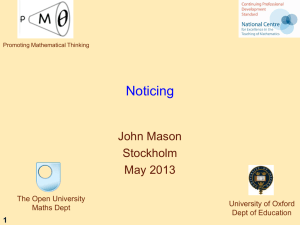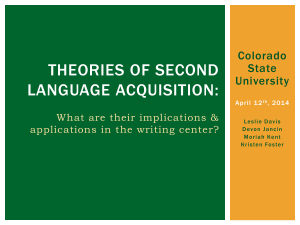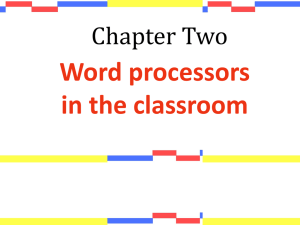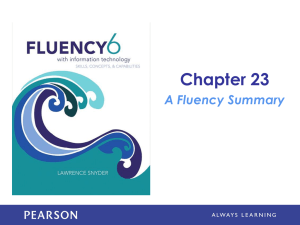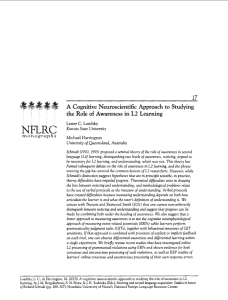Attention, awareness, `noticing` and foreign language learning
advertisement
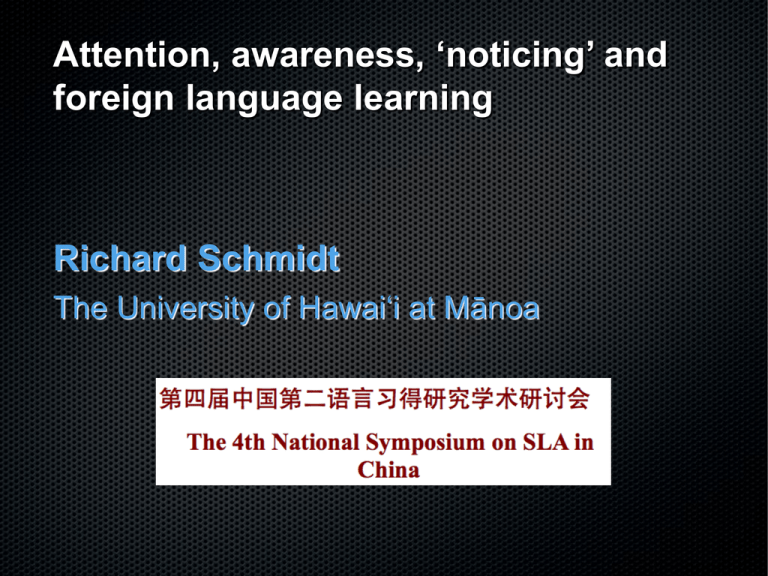
Attention, awareness, ‘noticing’ and foreign language learning Richard Schmidt The University of Hawai‘i at Mānoa The Noticing Hypothesis Intake is that part of the input that the learner notices (Schmidt, 1990, 139) The noticing hypothesis claims that awareness at the point of learning (Time 1) is required for all learning (Schmidt, 1995, 27) SLA is largely driven by what learners pay attention to and notice in target language input and what they understand the significance of noticed input to be (Schmidt, 2001, 3-4) Precursers to the Noticing Hypothesis The “Wes” Study (Schmidt, 1983) “Yesterday I’m go beach” “If you back to room, can I bring cigarette?” (would you please) “So tonight, Tim and me we are come back here early, we are apartment” “She’s name is Izumi Ukimura, she’s working is beautiful” Diary study of a learner of Portuguese (Schmidt & Frota, 1986) Classroom instruction was useful. Frequency in input was important. Some forms were taught and frequent but still were not learned until they were noticed (o que é que). Notice the gap: “For acquisition to occur, acquirers need to notice a difference between their current form or competence i and the new form or structure i + 1” (Krashen, 1983, 140) The role of consciousness in second language learning (Schmidt 1990) Consciousness as intention (incidental vs. intentional learning) • Claim: Incidental learning is possible and often effective, but paying attention is facilitative and may be necessary in some cases. Consciousness as attention • Claim: There is no learning without attention Consciousness as awareness • Claim: Awareness at the level of “noticing” is necessary; Awareness at the level of “understanding” is facilitative. Noticing •Raw/primary data: direct input from Source native speakers (oral or written) •Specific, particular instances (exemplars, tokens) Understanding •Stored data activated into working memory •Secondary data (information from dictionaries, grammars, teachers comments, etc.) •Attention to surface form and meaning in context •Online cognitive registration of sensory stimuli Processing stage •Detection within selective attention (Tomlin & Villa, 1994) •Detection plus rehearsal in shortterm memory (Robinson, 1995) Resulting knowledge type Analysis: •Comparisons across instances, hypothesis formation & testing, etc.) •Inspection of secondary data •Item learning •System learning •Episodic memory of who said what •Metalinguistic awareness when •Learning without “noticing” = subliminal learning Learning without “understanding” = implicit learning “Noticing” vs. “understanding” Noticing vs. understanding: transitive “grow” (Pullam, 2005) “Now, we can do the right thing and create jobs and grow our economy. This is really an age of remarkable possibility for our Nation.” (William J. Clinton, Presidential radio address, March 30, 1996) “After seeing Guy's “Growing a Language” a few months ago I went around telling everyone I knew about it, regardless of interest in programming.” (Tauber, 1998) “If I were God, using ‘grow’ as a transitive verb would give the speaker an instant hangnail.” (Twitter post by hotdogsladies, May 12, 2008) “John McCain has a better plan. Grow jobs, grow our economy ... not grow Washington" (campaign ad, April, 2008) Impact and associated ideas A resurgence in interest in basic issues concerning implicit and explicit learning (Robinson, 1995, 1996; Ellis, 1994; Hulstijn & Ellis, 2005) Merrill Swain’s output hypothesis (Swain, 1998) Bill VanPatten’s proposals for input-processing instruction (VanPatten, 2002) Rod Ellis’ form-focused instruction and proposals for consciousnes-raising tasks (Ellis, 2001) Michael Long’s revised interaction hypothesis (Long, 1996) Negotiatio n Attention Learning Noticing Model of Interaction and Learning (Gass and Mackey, 2006) p s e d r m d 9 s 11 m ei n t i e r o n r 11 across: 3rd person pl preterite of the verb mentir 9 down: the opposite of no in Spanish n Leow, 1997 3 p 4 4 s e d u r m i ó d 9 i 5 m i n t i e r o n r 4 across: 3rd person sing preterite of the verb dormirse o n 5 across: 3rd person pl preterite of the verb mentir 3 down: 3rd person pl preterite of the verb pedir Leow, 2000 Feedback, noticing and instructed L2 learning (Mackey 2006) Participants: students in a university level intensive ESL program Targets: questions, plurals, and past tense forms Multiple measures of noticing Learners report more noticing when feedback is provided. Learners who noticed more developed more. Output, input enhancing & noticing (Izumi, 2002) Target: English relative clauses H1: Output subjects will notice more than non-output subjects (confirmed) H2: Enhanced-input subjects will notice more than non-enhanced-input subjects (confirmed) H3: Output subjects will learn more than non-output subjects (confirmed) H4: Enhanced-input subjects will learn more than non-enhanced-input subjects (not confirmed). Major challenges and objections to the Noticing Hypothesis Objection 1: The temporal granularity of diary studies is too coarse. (Tomlin & Villa, 1994) Objection 2: Finer grained analyses of the language learning problem and the construct of attention are required. (Tomlin & Villa, 1994) Objection 3: Of the three functional subsystems of attention (alertness, orientation, detection), detection is crucial – but detection does not require awareness. (Tomlin & Villa, 1994; Williams, 2005) gi dog the near dog ul dog the far dog ro book the near book ne book the far book The lady spent many hours sewing… ‣gi cushions ‣ro cushions The art collector went to Greece to collect… ‣ne vases ‣ul vases Living Non-living near far near far gi ul ro ne Williams, 2005 Aware subjects (N= 8) Unaware subjects (N= 33) 94.4% 61.7% Williams, 2005. Results for Experiment 1, first test phase, performance on generalization items. Objection 4: Attention/awareness may be necessary for some kinds of learning but not others. “... although I (among many others) am perfectly willing to agree that learning individual words (the lexicon), individual sounds (the phonetic inventory), and writing systems must be via attentional focus, I am not the least willing to say that learning phonological, morphological and syntactic rules requires this attentional focus.” (Schachter, 19980) “... some linguistic items are too rare, abstract, complex, or semantically opaque, or have too many irregularities to be explicitly noticeable by learners. The article system in English is a typical problem for learners of many different native languages. But the fact that learners with no apparent metalinguistic knowledge are often successful with complex linguistic structures such as the English article system suggests that implicit learning can occur in such cases. Indeed, with low literate adolescents and adult, this type of implicit learning of L2 systems may be the norm.” (Tarone, Bigelow, & Hansen, 2009) Can the definite article be used with personal names? Normally not: *The Maria never comes on time. A Maria nunca chega a tempo. Exception: the definite article + title + PN construction the Marquis de Sade the Ayatollah Khomeini Exception: post-modified or pre-modified PN The real McCoy the John McCain of 2000 •Exception: the PN + definite article + NP construction • William the Conqueror (French: Guillaume le Conquérant), a.k.a. William the Bastard • Catherine the Great • Jack the Ripper • Nick the Greek Exception: the definite article + PN of NP construction Marie Cirillo “The Mother Teresa of rural Appalachia” Mother Teresa Barack Obama John Kennedy “The John Kennedy of our Time” ... http://www.rightpundits.com/?p=1747 Objection 5: Attention to environmental stimuli does not play a direct role in acquisition because most of what constitutes linguistic knowledge is not in the input to begin with. (Carroll) Objection 6: Language is a social object, not a mental one (Block, 2003). “ . . . there is no reason to look under the skull since nothing of interest is to be found there but brains.” (Garfinkel, 1963: 90) “[t]here is nothing ‘mental’ about thinking, intending or interpreting. It is we as agents (not as ‘minds’) who do these things when we do them” (Coulter, 2005, p. 92). Conclusions: What we don’t know The claim that all learning requires attention is controversial The claim that learning is possible without attention is equally controversial The claim that all learning requires awareness, at least at the level of noticing, remains controversial. The claim that people can learn things (e.g. words, morphemes, constructions) that they are not aware of is equally controversial. Claims that people can or cannot/do or do not learn abstract systems without awareness is particularly controversial. Conclusions: What we do know People learn about the things that they attend to and do not learn much about the things they do not attend to. (James, 1890, Logan et al., 1996; Schmidt, 2001) New associations are best learned explicitly. At the same time, implicit learning (acquisition of knowledge about the underlying structure of a complex stimulus environment by processes that takes place naturally and without conscious operations) is also possible. (Ellis, 2002) Promising methodologies for future research Conversational analysis (CA) can show how participants in interaction jointly manage their attentional focus (Firth, 2009) Promising methodologies for future research Eye-tracking technology has the potential to discover behavioral indicators or cognitive operations including perception & noticing (Godfroid, Hausen & Boers, 2010 Promising methodologies for future research fMRI studies of the neural correlates of artificial grammar learning may shed light on implicit and explicit learning mechanisms of natural languages (Skosnic et al, 2002) In the meantime: Implications for teaching Teaching is helping to learn: One of the most important responsibilities of teaching is to help students notice things that they are unlikely to notice on their own. Classroom tasks are a powerful determinant of attention. Students are like to pay attention to and to learn the information to complete pedagogical tasks. Explicit: deductive methods are generally superior to implicit: inductive methods in the short run, but both are necessary for the long run. In the meantime: Implications for learners Pay attention to input Pay particular attention to whatever aspects of the input that you are concerned to learn Look for clues (generalizations, rules) If you cannot find a general principle, concentrate on noticing on how particular instances are used in specific contexts Thank you for your attention!
